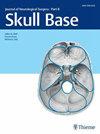硬膜外夹层移植用于垂体手术:4年的机构经验
IF 0.9
4区 医学
Q3 Medicine
引用次数: 0
摘要
摘要:目的采用不同复杂性和有效性的鞍区修复技术来减少经蝶窦垂体内窥镜手术后脑脊液(CSF)泄漏的发生率。本研究描述了我们的机构经验,以极简,高效的方法进行销售修复。方法对我院连续行经蝶窦垂体手术的病例进行回顾性分析。所有纳入的受试者均采用硬膜外夹层移植进行鞍区修复。研究了患者与肿瘤特征、脑脊液泄漏发生率、辅助修复技术和内分泌结果之间的关系。结果共纳入334例病例。术中脑脊液漏116例(34.7%),术后早期脑脊液漏1例(0.3%)。术中仅硬膜外夹层即可成功修复70例脑脊液泄漏,其中13例为高流量泄漏。在本系列的后半部分,我们的脂肪移植(1.2%)、鼻中隔瓣(3.0%)和腰椎引流管放置(6.6%)的使用率与前半部分相比显著下降,表明随着时间的推移,对夹层移植的依赖增加。我们65%的功能性大腺瘤缓解率与大型历史系列相比是有利的。结论单纯鞍区硬膜外夹层修复术可有效预防术后脑脊液泄漏,包括术中高流量脑脊液泄漏。更复杂的修复技术保留给选择高风险的病例或那些不充分的骨嵴。在我院连续300多例经蝶窦垂体手术中,无一例术后脑脊液泄漏。本文章由计算机程序翻译,如有差异,请以英文原文为准。
Epidural Interlay Graft for Pituitary Surgery: A 4-Year Institutional Experience
Abstract Objective Sellar repair techniques with varying complexity and effectiveness have been employed to reduce the incidence of postoperative cerebrospinal fluid (CSF) leaks following endoscopic transsphenoidal pituitary surgery. This study describes our institutional experience with a minimalistic, highly effective approach to sellar repair. Methods The authors performed a retrospective review of consecutive cases of transsphenoidal pituitary surgery performed at our institution. All included subjects underwent sellar repair with an epidural interlay graft. Relationships between patient and tumor characteristics, incidence of CSF leak, adjunct repair techniques, and endocrine outcomes were examined. Results Three hundred and thirty-four (334) cases were included. Intraoperative CSF leak was encountered in 116 cases (34.7%), and postoperative CSF leak occurred only once (0.3%) early in the series. Seventy intraoperative CSF leaks were successfully repaired with an epidural interlay alone, including 13 high-flow leaks. Our rate of fat graft use (1.2%), nasoseptal flap (3.0%), and lumbar drain placement (6.6%) in the second half of the series showed a significant decline compared with the first half, indicating increased reliance on the interlay graft over time. Our 65% functional macroadenoma remission rate compares favorably with large historical series. Conclusions Simple sellar repair using an epidural interlay graft is highly effective in preventing postoperative CSF leaks, including cases of high-flow intraoperative leaks. More complex repair techniques are reserved for select high-risk cases or those with inadequate sellar bony ledges. With this technique, there has been no postoperative CSF leak at our institution in over 300 consecutive transsphenoidal pituitary surgeries.
求助全文
通过发布文献求助,成功后即可免费获取论文全文。
去求助
来源期刊

Journal of Neurological Surgery Part B: Skull Base
CLINICAL NEUROLOGY-SURGERY
CiteScore
2.20
自引率
0.00%
发文量
516
期刊介绍:
The Journal of Neurological Surgery Part B: Skull Base (JNLS B) is a major publication from the world''s leading publisher in neurosurgery. JNLS B currently serves as the official organ of several national and international neurosurgery and skull base societies.
JNLS B is a peer-reviewed journal publishing original research, review articles, and technical notes covering all aspects of neurological surgery. The focus of JNLS B includes microsurgery as well as the latest minimally invasive techniques, such as stereotactic-guided surgery, endoscopy, and endovascular procedures. JNLS B is devoted to the techniques and procedures of skull base surgery.
 求助内容:
求助内容: 应助结果提醒方式:
应助结果提醒方式:


